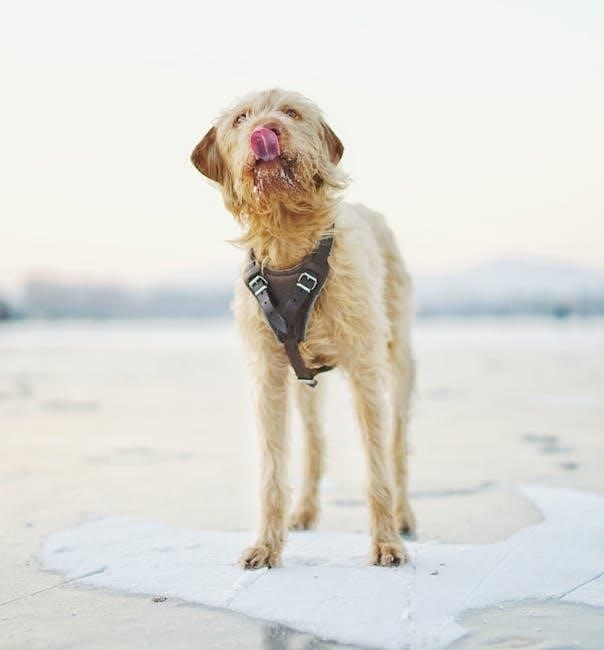Welcome to our comprehensive guide on dog guide harnesses! These essential tools offer comfort, control, and safety for dogs during walks, hikes, or specialized tasks. Learn how to choose the right harness for your furry companion, ensuring a perfect fit and optimal performance. Discover the benefits of different styles, materials, and features designed to enhance your dog’s comfort and your peace of mind. Whether for everyday use or specific activities, a well-selected harness is a must-have for every dog owner.
What is a Dog Guide Harness?
A dog guide harness is a specially designed tool for controlling and guiding dogs comfortably. It distributes force across the chest and shoulders, reducing neck strain. Ideal for walks, training, or assisting service dogs, guide harnesses prioritize comfort, safety, and ease of use. They often feature adjustable straps and durable materials, making them versatile for various activities and dog sizes.
The Importance of a Guide Harness for Dogs
A guide harness is essential for ensuring your dog’s comfort and safety during walks or tasks. Unlike collars, it reduces neck strain, making it ideal for dogs prone to pulling. Guide harnesses also provide better control, especially for strong or energetic breeds. They are crucial for service dogs, offering clear identification and functional support. investing in a good harness promotes enjoyable outings and effective training;
Types and Styles of Dog Guide Harnesses
Dog guide harnesses come in various styles, including vest-style, padded, tactical, and no-pull designs. Each type offers unique features to suit different needs, ensuring comfort and functionality.
Vest-Style Harnesses
Vest-style harnesses are lightweight and breathable, making them ideal for everyday use. They typically feature a simple design with a sleeve that slips over the dog’s head and shoulders. These harnesses are perfect for dogs with sensitive skin or those who prefer minimal coverage. The vest-style is easy to put on and take off, offering a comfortable fit for casual walks or training sessions. Their popularity stems from their practicality and ease of use.
Padded Harnesses
Padded harnesses offer enhanced comfort with cushioned panels, ideal for dogs requiring extra support. They feature breathable materials and adjustable straps for a secure fit. These harnesses are perfect for long walks or dogs that pull, reducing strain on the chest. The padding ensures minimal chafing and maximizes comfort, making them a great choice for dogs with mobility issues or sensitive skin. They are durable and easy to clean, ensuring long-lasting use.
Tactical Harnesses
Tactical harnesses are designed for durability and functionality, often used for outdoor adventures or working dogs. They feature reinforced materials, multiple attachment points, and MOLLE systems for gear. Padded chests and adjustable straps ensure comfort during extended use. These harnesses are ideal for activities like hiking, search and rescue, or service tasks, providing both practicality and comfort for active dogs. They are built to withstand rigorous conditions and offer versatility for various needs.
No-Pull Harnesses
No-pull harnesses are specifically designed to discourage dogs from pulling on the leash, making walks more enjoyable. These harnesses typically feature front-clip leash attachments that redirect the dog’s attention when they pull. They are made with comfortable, breathable materials and often include padded chest plates for added comfort. No-pull harnesses are ideal for training purposes and are especially useful for strong or energetic dogs, promoting better walking behavior while ensuring the dog’s safety and comfort.
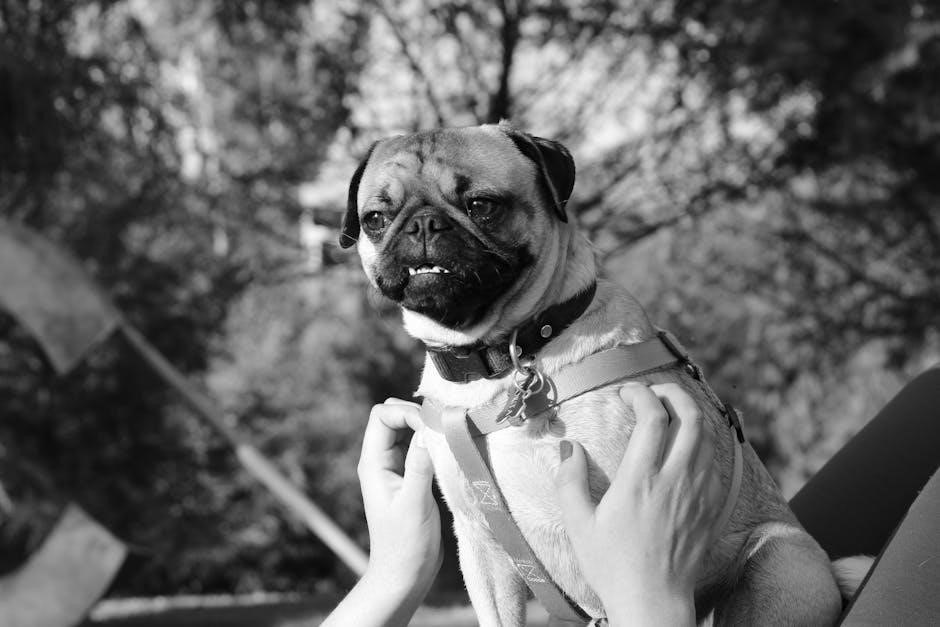
Choosing the Right Dog Guide Harness
Selecting the perfect dog guide harness involves considering your dog’s size, breed, and activity level. Ensure proper fit for comfort and safety, and choose features that suit your lifestyle and training needs.
Factors to Consider When Selecting a Harness
When selecting a dog guide harness, consider factors such as your dog’s size, breed, and activity level. Ensure proper fit for comfort and safety, and choose features that suit your lifestyle and training needs. Durability, weather resistance, and adjustability are crucial for long-lasting use. Reflective elements enhance visibility, while leash attachment options provide flexibility. Prioritize materials that prevent skin irritation and chafing, ensuring your dog’s comfort during extended wear.
Size and Fit: Ensuring Comfort and Safety
Proper sizing and fit are crucial for your dog’s comfort and safety. A poorly fitted harness can cause discomfort or even safety risks. Measure your dog accurately, focusing on chest and neck circumference. Choose adjustable straps to ensure a snug yet comfortable fit. Regularly check the fit to accommodate growth or weight changes. A well-fitted harness prevents chafing and ensures your dog can move freely without restriction.

Dog Harness Sizing and Measurement
Proper sizing ensures a comfortable, safe fit. Use a flexible tape measure to determine your dog’s chest circumference at its broadest point for accurate sizing and the best fit.
How to Measure Your Dog for a Harness
Measuring your dog accurately ensures a proper fit. Use a flexible tape measure around the broadest part of their chest, just behind the front legs. Ensure the dog stands naturally, with the tape measure snug but not tight. Record the circumference to match it with the size chart. This step prevents discomfort and ensures optimal support and mobility for your dog.
Understanding Size Charts and Adjustability
Size charts vary by brand, so always refer to the manufacturer’s guidelines. Proper measurement ensures the best fit, while adjustable straps allow customization. A well-fitted harness prevents chafing and enhances comfort. Use the provided size charts to match your dog’s measurements for optimal support and mobility. Adjustability ensures the harness grows with your dog, offering long-term comfort and reliability.
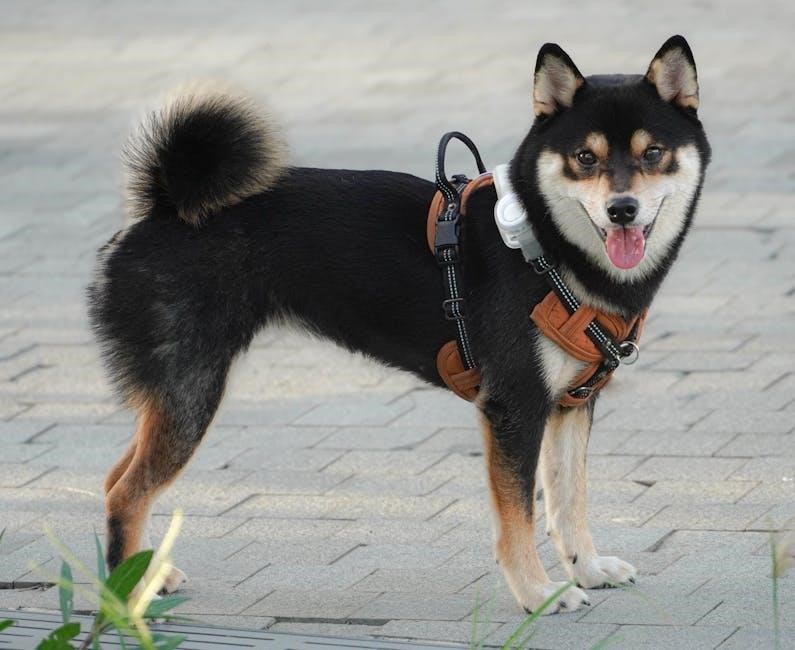
Materials and Durability
Durable materials like nylon and polyester ensure longevity, while padded harnesses provide comfort. Weather-resistant designs withstand outdoor conditions, making them ideal for active dogs. Quality hardware enhances reliability.
Common Materials Used in Dog Harnesses
Dog guide harnesses are typically made from durable, weather-resistant materials such as nylon, polyester, and neoprene. These fabrics offer strength, flexibility, and comfort. Padded sections often use soft, breathable mesh for skin protection. Metal or plastic hardware ensures secure buckle closures. Some harnesses incorporate reflective elements for visibility, while others may feature reinforced stitching for added durability in demanding conditions.
Durability and Weather Resistance
High-quality dog guide harnesses are designed to withstand various weather conditions and heavy use. Waterproof and UV-resistant materials prevent degradation from rain or sun exposure. Reinforced stitching and rust-proof hardware enhance longevity. These features ensure the harness remains functional and comfortable for your dog, whether hiking in wet terrain or navigating urban environments, providing reliability and durability over time.

Key Features of a Dog Guide Harness
A guide harness should have adjustable straps for a custom fit, reflective elements for visibility, and durable attachment points. These features ensure comfort, safety, and control during walks or tasks, making it an essential tool for dog owners seeking reliability and ease of use.
Adjustable Straps and Custom Fit
Adjustable straps are a crucial feature of dog guide harnesses, ensuring a tailored fit for your dog’s unique shape and size. Properly fitted harnesses prevent discomfort or chafing, while allowing for a full range of motion. By customizing the fit, you can enhance your dog’s comfort and safety, making walks or tasks more enjoyable and stress-free for both you and your pet.
Reflective Elements for Visibility
Reflective elements on dog guide harnesses enhance visibility, ensuring your dog is easily seen in low-light conditions. These features, such as reflective strips or patches, help others detect your dog’s presence, improving safety during nighttime walks or in busy environments. By increasing visibility, reflective elements provide peace of mind for handlers and help prevent accidents, making them a vital component of a functional and safe harness design.
Leash Attachment Options
Leash attachment options on dog guide harnesses offer versatility and convenience. Many harnesses feature durable D-rings or clips for secure leash connection, while others include multiple points for varied control. Some designs allow for front or back attachment, catering to different training needs. These options ensure a comfortable and customizable experience, making it easier to manage your dog in various situations, from casual strolls to active adventures.

Training Your Dog to Use a Harness
Training your dog to use a harness involves introducing it gradually, ensuring comfort, and using positive reinforcement techniques to build confidence for a stress-free walking experience.
Introducing the Harness to Your Dog
Introducing the harness to your dog should be a calm and positive experience. Start by letting your dog sniff and explore the harness at their own pace. Place it near their favorite toys or treats to create a welcoming environment. Gradually put the harness on your dog for short periods, rewarding them with praise and treats to associate it with positive outcomes. Avoid forcing the harness on your dog, as this can create resistance or anxiety. Instead, make it a fun process where your dog feels comfortable and secure. Consistency and patience are key to ensuring your dog accepts the harness willingly, making future training sessions easier and more effective. This approach helps build trust and confidence, setting the foundation for successful harness use.
Positive Reinforcement Training Techniques
Positive reinforcement is a powerful method for training your dog to use a harness. Start by placing the harness near your dog’s favorite treats or toys to create a positive association. Reward your dog with treats and praise when they calmly approach or wear the harness. Begin with short sessions, gradually increasing the duration as your dog becomes comfortable. Avoid negative experiences, such as forcing the harness on, which can lead to resistance. Instead, make the process enjoyable and rewarding, ensuring your dog associates the harness with positive outcomes. Consistency and patience are key to a stress-free and effective training experience.
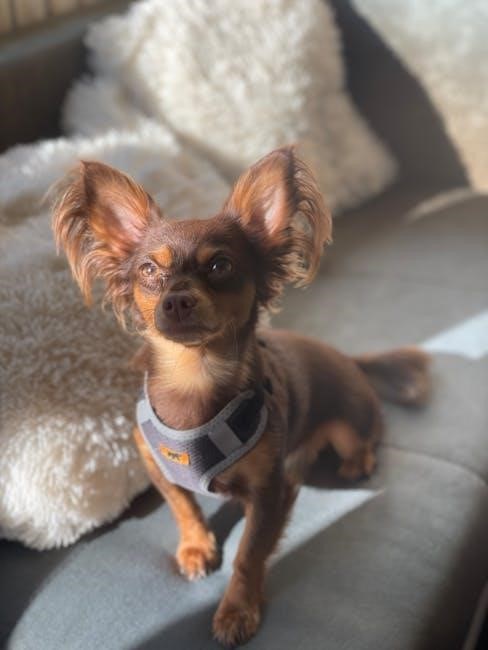
Safety and Health Considerations
Ensure proper fit to prevent discomfort or injury. Use high-quality materials to avoid skin irritation. Regularly inspect the harness for wear and tear. Monitor your dog’s behavior for signs of distress. Always prioritize your dog’s comfort and health when using a guide harness;
Preventing Skin Irritation and Chafing
Choose a harness with breathable, soft materials to reduce friction. Ensure a proper fit to avoid tight spots that can cause chafing. Regularly inspect the harness for wear and tear, replacing it if necessary. Monitor your dog’s skin for signs of irritation and adjust the harness as needed. Consider padded areas for extra comfort and to prevent rubbing. Clean the harness frequently to maintain hygiene and prevent skin issues.
Monitoring Your Dog’s Comfort and Behavior
Always observe your dog’s behavior and physical signs while wearing the harness. Look for signs of discomfort, such as squirming or avoiding the harness. Check for redness or chafing under the straps. Ensure the harness isn’t too tight or restrictive. Introduce the harness gradually to help your dog adjust. Reward calm behavior to build confidence. Regular checks ensure long-term comfort and prevent skin irritation or anxiety.
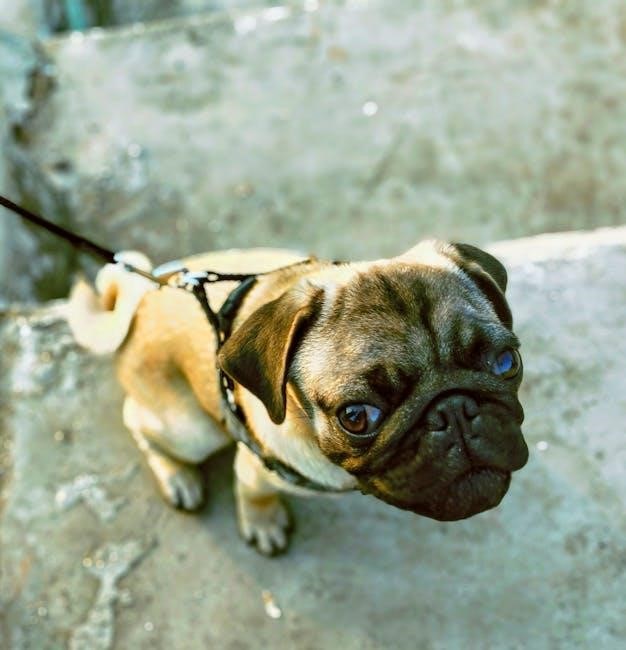
Accessorizing Your Dog’s Guide Harness
Elevate your dog’s harness with functional accessories like ID tags, reflective patches, and matching leashes. These additions enhance visibility, personalize the gear, and ensure a secure, stylish fit.
Adding Identification Tags and Patches
Enhance your dog’s guide harness with identification tags and patches for safety and personalization. ID tags ensure your dog can be easily identified, while reflective or embroidered patches boost visibility. Choose from various styles, such as customizable name tags or service dog indicators, to suit your needs. These accessories not only add functionality but also give the harness a unique, polished look. Secure them firmly to avoid irritation or stress for your dog.
Using Harness-Compatible Leashes and Collars
Pair your dog’s guide harness with compatible leashes and collars for a seamless, comfortable experience. Choose leashes made from durable materials like nylon or padded neoprene to prevent chafing. Ensure the collar complements the harness, avoiding unnecessary strain or irritation. Opt for styles that match your harness’s design for a cohesive look. Properly fitted accessories enhance both functionality and your dog’s comfort during walks or activities.
Real-Life Applications of Dog Guide Harnesses
Dog guide harnesses are vital for service dogs, hiking adventures, and daily walks, offering support, control, and comfort for both the dog and handler in various activities.
Service Dogs and Assistance Harnesses
Service dogs rely on specialized harnesses designed for functionality and comfort. These harnesses often feature identification patches, ensuring public awareness of the dog’s role. Durable materials and secure leash attachments are essential for handlers with disabilities, providing stability and control. Reflective elements enhance visibility, while padded areas prevent discomfort during long work hours. Proper fitting ensures the dog can move freely, maintaining focus on assisting their handler effectively. Regular maintenance is crucial to extend the harness’s lifespan and reliability in critical situations.
Hiking and Outdoor Adventures with Your Dog
Hiking with your dog requires a durable, weather-resistant harness to ensure comfort and control. Look for padded chest plates, breathable materials, and reinforced stitching to withstand rugged trails. Reflective elements enhance visibility in low-light conditions, while adjustable straps provide a secure fit. A good harness should allow freedom of movement for your dog, distributing weight evenly to prevent strain. It’s a must-have for safe and enjoyable outdoor adventures with your furry companion.

Maintenance and Care
Regular cleaning and proper storage extend your dog guide harness’s lifespan. Remove dirt with mild soap and dry thoroughly to prevent odor. Store in a cool, dry place to maintain quality and ensure your dog’s comfort and safety.
Cleaning and Storing the Harness
Cleaning and storing your dog guide harness properly ensures durability. Use mild soap and warm water to remove dirt and odors. Avoid harsh chemicals that may damage materials. Allow the harness to air dry completely to prevent mold. Store it in a cool, dry place away from direct sunlight to maintain its condition and extend its lifespan. Regular maintenance keeps your dog comfortable and safe, ensuring the harness remains in great shape for future use.
When to Replace a Worn-Out Harness
Replace your dog guide harness when it shows signs of wear, such as frayed straps, broken buckles, or thinning padding. If the harness no longer fits securely or causes discomfort, it’s time for a new one. Holes, cracks, or weakened materials can compromise safety. Regular inspections ensure your dog’s harness remains reliable and comfortable, preventing potential issues during use.
Troubleshooting Common Issues
Identify signs of wear, such as frayed straps or broken hardware, and address discomfort or resistance promptly. Adjust the fit or replace damaged parts to ensure safety and functionality.
Addressing Discomfort or Resistance
If your dog shows signs of discomfort or resistance, inspect the harness for proper fit and adjust straps to prevent chafing. Ensure the harness isn’t too tight or restrictive. Introduce it gradually, using positive reinforcement techniques like treats and praise. If issues persist, consider consulting a professional trainer or trying a different style to meet your dog’s specific needs and preferences for optimal comfort and cooperation during walks or activities.
Fixing Broken Straps or Hardware
If your dog’s guide harness has broken straps or hardware, assess the damage first. For minor tears, use a repair kit with durable materials like nylon or metal. If the damage is extensive, consider replacing the harness entirely. Always consult a professional if unsure, as a faulty harness can compromise safety. Regular inspections and timely repairs ensure your dog’s harness remains functional, comfortable, and secure for everyday use or specialized tasks.
A high-quality dog guide harness is a vital tool for safety, comfort, and control, offering peace of mind for both you and your dog in various activities and situations.
Final Thoughts on Dog Guide Harnesses
A well-chosen dog guide harness can significantly enhance walks, hikes, and training sessions, ensuring comfort and control. By prioritizing fit, durability, and features tailored to your dog’s needs, you can create a safer and more enjoyable experience for both you and your furry companion. Remember, the right harness is an investment in your dog’s well-being and your peace of mind.
Encouragement to Explore More Resources
Exploring more resources can deepen your understanding of dog guide harnesses and help you make informed decisions. Check out reputable brands, online forums, and training guides to discover what works best for your dog. Whether you’re a first-time buyer or a seasoned owner, continuous learning ensures a safe and enjoyable experience for both you and your furry friend.

Resources and Further Reading
Explore reputable brands, product reviews, and training guides to find the best dog guide harness for your needs. Online communities and forums offer valuable insights and recommendations.
Recommended Products and Brands
Top brands like Ruffwear, Blueberry Pet, and Kurgo offer high-quality dog guide harnesses. These brands provide durable, adjustable, and comfortable designs suitable for various activities. Ruffwear’s padded harnesses are ideal for hiking, while Blueberry Pet offers stylish and functional options. Kurgo specializes in crash-tested harnesses for car safety. These brands ensure your dog’s comfort and your peace of mind with well-crafted, reliable products.
Online Communities and Forums for Dog Owners
Join online forums like Reddit’s r/dogtraining or r/offleash, where owners share insights on dog guide harnesses. Specialized groups focus on service dogs or outdoor adventures, offering advice and recommendations. These platforms allow you to ask questions, troubleshoot issues, and learn from experienced owners, ensuring you make informed decisions for your dog’s comfort and safety with the right harness.
